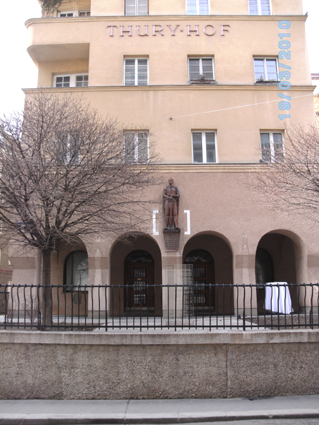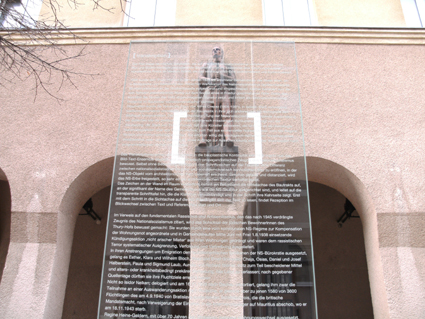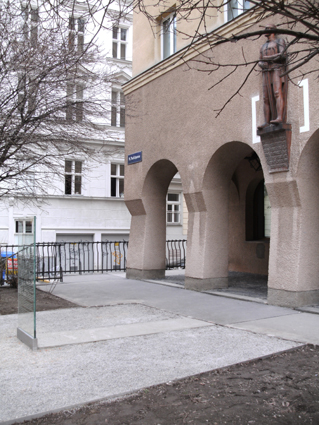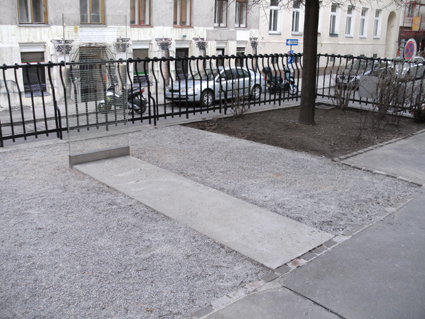Der Titel dieser räumlichen Installation, die auf eine dem Nationalsozialismus verhaftete und dessen Blut und Boden-Ideologie propagierende Bauplastik referiert, bezeichnet eine forschungsbasierte künstlerische Praxis im Medium Schrift, die das verdrängte NS-Erbe problematisiert und kontextualisiert.
1939 wurde dem Thury-Hof, ein in den Jahren 1925/26 errichteter Gemeindebau des Roten Wien, ein
in Bildsprache und Gestaltung den völkischen Wertekanon des Nationalsozialismus repräsentierendes
Sinnbild prominent an der Straßenfassade aufgepflanzt und eingeschrieben. Seither inszeniert sich der
sein Schwert präsentierende Recke auf dem Sockel eines in Fraktur geschriebenen Hitler-Zitats, das
kenntlich die Spuren der 1945 abgeschlagenen Signatur zeigt, und irritiert als nationalsozialistisches
Implantat im Baukörper sozialdemokratischer Identität.
Geschaffen wurde die Terrakotta-Figur von Alfred Crepaz (1904-1991), in dessen Werk vorwiegend
traditionsgebundener christlicher Kunst die Bauplastik in ihrer sich andienenden NS-Ikonografie den
Bildhauer kompromittiert. Die mit der Machtergreifung der Nationalsozialisten einsetzende Ausschaltung
der jüdischen wie der politisch und/oder künstlerisch missliebigen Konkurrenz, gefolgt von der
'Säuberung' der Stadt von ihren Arbeiten, ließ jene Künstler reüssieren, die sich,
sei es als überzeugte Nationalsozialisten oder aus Opportunismus, zum Teil aus existenzieller Notwendigkeit,
vom NS-Regime fördern und instrumentalisieren ließen. Sie erfüllten willig die ideologisch-
ästhetischen Vorgaben eines Wettbewerbs oder, wie in diesem Fall, eines Auftrags zur Ausschmückung
städtischer Wohnbauten nach programmatischen Worten des Führers.
Das Transkriptionszeichen als Intervention in die bauplastische Kontinuität seit 1939 macht nun das
Bild-Text-Ensemble deutlich und als ästhetisch-propagandistisches Zeugnis des Nationalsozialismus
bewusst. Selbst ohne Bedeutung, ermöglicht das Schriftzeichen auf der Fassade, eine Differenz
zwischen nationalsozialistischer Skulptur und sozialdemokratisch konnotiertem Bau zu eröffnen, in der
das NS-Objekt vom architektonischen Feld separiert erscheint. Simultan gefasst und distanziert, wird
das NS-Erbe freigestellt, so sehr es der architektonischen Textur verhaftet bleibt.
Das Zeichen an der Wand im Raum wiederholt, nimmt ein Betonband die Mittelachse des Bautrakts auf,
an der signifikant der Name des Gemeindebaus wie die NS-Skulptur ausgerichtet sind, und leitet auf die
transparente Schrifttafel hin, die die Klammer vervollständigt und in der Schrift ihre Kehrseite zeigt.
Erst mit dem Schritt in die Sichtachse auf die NS-Plastik gibt sich der Text zu lesen, findet Rezeption im
Blickwechsel zwischen Text und Referenzfeld statt und Ort.
Im Verweis auf den fundamentalen Rassismus und Antisemitismus, den das nach 1945 verdrängte
Zeugnis des Nationalsozialismus zitiert, wird das Schicksal der jüdischen BewohnerInnen des
Thury-Hofs bewusst gemacht: Sie wurden durch eine vom kommunalen NS-Regime zur Kompensation
der Wohnungsnot angeordnete und in Gemeindebauten Mitte Juni mit Frist 1.8.1938 einsetzende
Kündigungsaktion ,nicht arischer Mieter' aus ihren Wohnungen gedrängt und waren dem rassistischen
Terror systematischer Ausgrenzung, Verfolgung und Vertreibung ausgeliefert.
In ihren Anstrengungen um Emigration den raubökonomischen Schikanen der NS-Bürokratie ausgesetzt,
gelang es Esther, Klara und Wilhelm Bloch, Rosa und Ernst Grünwald, Chaja, Osias, Daniel und Josef
Halberstein, Paula und Sigmund Laub, Aurelia und Richard Steiner, trotz zum Teil bescheidener Mittel
und alters- oder krankheitsbedingt prekärer Verfassung, das Land zu verlassen; nach gegebener
Quellenlage dürften sie ihre Fluchtziele erreicht haben.
Nicht so Isidor Nelken: delogiert und am 16.11.1938 nach Dachau deportiert, gelang ihm zwar die
Teilnahme an einer Auswanderungsaktion nach Palästina, er gehörte aber zu jenen 1580 von 3600
Flüchtlingen des am 4.9.1940 von Bratislava auslaufenden Schiffskonvois, die die britische
Mandatsmacht, nach Verweigerung der Einreise, in ein Internierungslager auf Mauritius abschob, wo er
am 18.11.1943 starb.
Regine Heine-Geldern, mit über 70 Jahren den Strapazen mehrerer Wohnungswechsel ausgesetzt,
starb am 10.2.1939 in einer Wiener Krankenanstalt.
Jakob Lipschitz konnte mit Hilfe seiner nichtjüdischen Ehefrau in Wien überleben.
Franziska Rosenberg und ihre Tochter Julie setzten mangels eines für sie möglichen Auswegs ihrem
Leben vor Ablauf der Kündigungsfrist am 24.7.1938 selbst ein Ende.
Ihrer als Opfer des Nationalsozialismus zu gedenken sind die Namen der jüdischen Frauen und Männer
genannt; im Kontext des nationalsozialistischen Sinnbilds auf der Fassade konstituiert ihre namentliche
Präsenz hier einen Ort des Gedächtnisses.




[transcription]
The title of this spatial installation, which refers to an architectural
sculpture rooted in National Socialism and propagating its blood and soil ideology, signifies
a research-based art practice in the medium of writing that questions and contextualizes the repressed
NS heritage.
In 1939, a symbol representing the canon of National Socialist values in its iconography and design was
prominently planted on and inscribed into the street façade of the Thury-Hof, a municipal housing
block of Red Vienna built in 1925 and 1926. Since then, the warrior
produces himself by presenting his sword on the socle of a Hitler quotation written in Fraktur, which
recognizably shows traces of the signature knocked off in 1945, and irritates as a National Socialist
implantation in a building of Social Democratic identity.
The terracotta figure was made by Alfred Crepaz (1904-1991), in whose oeuvre of predominantly tradition-bound
Christian art this work in its obsequious Nazi iconography compromises the sculptor. The elimination of Jewish
and politically and/or artistically unpopular competitors starting with the National Socialists' seizure of power,
followed by the 'purge' of the city from their works, paved the way for those artists' success who, as convinced
National Socialists or out of opportunism, partly by existential necessity, allowed the Nazi regime to support and
instrumentalize them. Willingly, they fulfilled the ideological-aesthetical guidelines of competitions or, like in
this case, of a commission for embellishing municipal housing projects after programmatic words by the Führer.
The transcription sign as an intervention into the sculptural continuity since 1939 now marks the image/text ensemble
and emphasizes it as an aesthetical-propagandistic legacy of National Socialism. Having no meaning in itself, the sign
on the façade allows to open up a difference between National Socialist sculpture and Social Democratic connation of
the building, a difference in which the Nazi object appears to be separated from the architectural field. Simultaneously
framed and dissociated, the NS legacy is isolated as much as it remains attached to the architectural texture.
Repeating the sign on the wall, a concrete band takes up the building's central axis, significantly aligning the name of
the housing block and the NS sculpture, and leads to the transparent panel, completing the parenthesis and showing writing
in reverse. Only by stepping into the NS sculpture's sight axis, the text is given to read; with the gaze shifting between
text and field of reference, reception takes place and finds its site.
Making reference to the fundamental racism and antisemitism quoted by the National Socialist legacy repressed after 1945
addresses the fate of the Jewish inhabitants of the Thury-Hof: to compensate housing shortage, by order of the communal
NS regime an operation against "non-Aryan tenants" in municipal housing blocks was launched in mid-June 1938; given notice
and forced out of their flats by August 1, they were subjected to the racist terror of systematic exclusion, persecution,
and expulsion.
In their endeavors to emigrate exposed to the harassments of NS robber economy, Esther, Klara and Wilhelm Bloch, Rosa and
Ernst Grünwald, Chaja, Osias, Daniel, and Josef Halberstein, Paula and Sigmund Laub, as well as Aurelia and Richard Steiner
managed to leave the country, despite their partly modest means and their precarious condition due to their age or illness;
according to the available sources, they seem to have reached their places of refuge.
Not so Isidor Nelken: though, evicted and deported to Dachau on November 16, 1938, he succeeded in joining an emigration
transport bound for Palestine - the convoy of ships carrying a total of 3,600 refugees departed from Bratislava on September 4,
1940 - he was among the 1,580 passengers who, after being refused entry by the British mandatory power, were deported to a
detention camp on Mauritius, where he died on November 18, 1943.
Regine Heine-Geldern, subjected to the strain of several changes of residence at an age of more than seventy, died in a
hospital in Vienna on February 10, 1939.
Jakob Lipschitz, with the help of his non-Jewish wife, could survive in Vienna.
Franziska Rosenberg and her daughter Julie did not find a way out; before the deadline of notice expired, they put an end
to their lives on July 24, 1938.
To remember them as victims of National Socialism, the names of the Jewish women and men are given: in the context of the
NS symbol on the façade, their presence constitutes a site of commemoration.